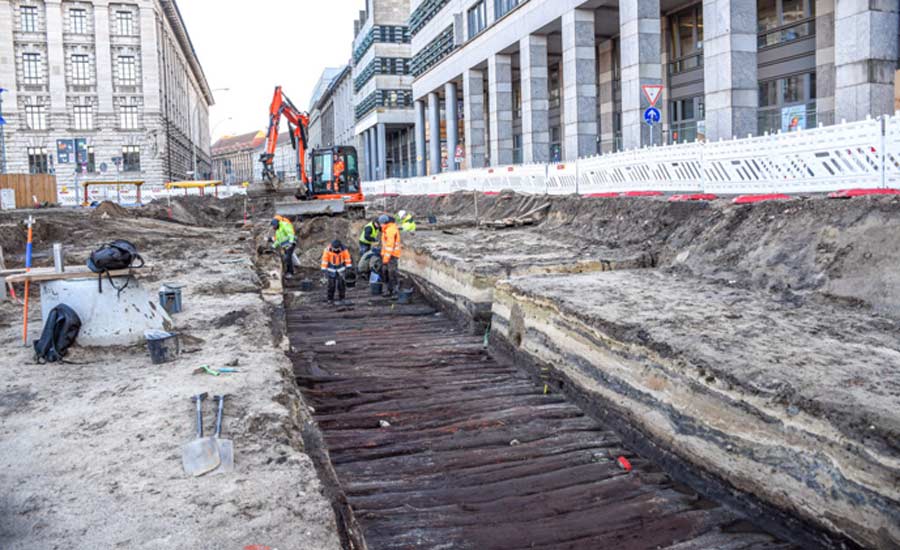700-year-old Causeway Found Under Central Berlin Street
Located in Berlin-Mitte in the German capital, Stralauer Straße has a storied history which is now known to stretch back to the medieval founding of Berlin in the year 1237. Excavations in January 2022 by archaeologists from Landesdenkmalamt Berlin (LDA) at Molkenmarkt, the oldest sqaure in Berlin, have revealed a medieval plank embankment roughly 2.5 meters (8.2 feet) below the surface.
Initial wood samples taken from the causeway have been tested using tree ring analysis, reports Archaeology News Network. The tests reveal the trees were cut down around 1238, dating the wooden planks to the earliest founding of Berlin.
The significance of the find cannot be understated, according to statements made by the German Senator for Culture and Europe Klaus Lederer, who called the discovery "a real hit". State curator Christoph Rauhut spoke of a "really significant find" and Matthias Wemhoff, state archaeologist of Berlin, even described it as a "real sensation", as per a Morgen Times report.
Remarkably Well Preserved
The dam-like structure is made from oak, pine, and birch trunks, trees found in abundance near and around the outskirts of the German capital. The embankment was uncovered unexpectedly during the laying of power and gas lines as part of the street reconstruction project around Molkenmarkt.
Luckily, the archaeologists were well prepared. Preparatory archaeological work is required to be carried out in case a situation precisely like this occurs.
- Mass Medieval Cemetery Sheds Light on Berlin’s Brutal Birth
- Grand Medieval Building Found Under Welsh Public Restrooms
The timbers managed to survive in such a good state of preservation over the last 700 years thanks to the efficient layering of peat in thick layers, which created an airtight structure. The embankment provided a safe passage from the Mühlendamm, a major central Berlin street, towards the nearby landmark of the Stralauer Tor.

50 m (164 feet) of the causeway has been uncovered so far (Landesdenkmalamt Berlin)
The planks would have helped bypass the mushy and wet ground near the river, allowing heavy goods and pedestrians to travel across central Berlin without fear of becoming bogged down by soft ground.
The structure has a width of 6 meters (19.6 feet) and runs for least 50 meters (164 feet) with the planks laid down in three layers. The top layer consists of debarked trunks (with the bark of the tree removed to prevent rotting) which lie side by side across the embankment, resting on three longitudinal parallel beams.
Defects in the top layer were covered up with small boulders, and sand was also employed to smoothen the edges, according to a press release by the State Monuments Office Berlin. The top layers of the road were also dated to the Middle Ages.
"The complex wooden fortification of the road here near the Spree enabled a safe passage from Mühlendamm in the direction of Stralauer Tor over the very wet ground near the river," says the same report from the State Monuments Office.
Infrastructure was a Priority
Several such boardwalk finds from the Middle Ages have been made, generally in excellent condition. Clearly, the Middle Ages, often termed the “Dark Ages” by historians, had gotten some things right, particularly road building.
- Built to Last: The Secret that Enabled Roman Roads to Withstand the Passage of Time
- Were the Dark Ages Really Dark?
The level of preservation on these finds was excellent. The first one was uncovered in Jüterbog in northeastern Germany in 2017, and more recently in 2021 a six meter (19.6 feet) wide boardwalk was found in the city of Dortmund, dating back 1,000 years, as per a report in National Geographic.

The top layer of timber has no bark which helped preserve the wood from rot (Landesdenkmalamt Berlin)
One of the key takeaways from the find, according to Wemhoff, is that the city displayed a dynamic attitude towards expansion and building good infrastructure, which was supported by the quality of the finds. "I didn't expect that we would have such fantastic wood preservation in Berlin and actually find organic material," said Wemhoff.
As the state archaeologist explained, most of the buildings in Berlin were built on islands of sand. "Hardly any of that has survived, but it's different here”, he concluded.
The State Monuments Office of Berlin now plans to conduct free guided tours of the Molkenmarkt excavation, starting with a regular time slot every Friday. If the tours prove popular, they hope to increase the frequency of this in the future, keeping the current pandemic in mind.
Top image: The causeway found on Berlin is remarkably well preserved. Source: Morgenpost.
By Sahir Pandey
References
ANN. 2022. Medieval Plank Causeway Discovered In Berlin. Available at: https://archaeologynewsnetwork.blogspot.com/2022/02/medieval-plank-causeway-discovered-in.html
Hanack, J. 2022. Mitte: Discovered one of the oldest streets in Berlin. Available at: https://www.morgenpost.de/bezirke/mitte/article234340733/Berlin-Mitte-Mittelalterliche-Strasse-entdeckt.html
Piatschek, N. 2022. Germany's oldest streets. Available at: https://www.nationalgeographic.de/geschichte-und-kultur/2022/01/deutschlands-aelteste-strassen
SMOB. 2022. Medieval plank embankment discovered in Stralauer Straße. Available at: https://www.berlin.de/landesdenkmalamt/aktuelles/kurzmeldungen/2022/neues-von-der-grabung-molkenmarkt-januar-2022-1170851.php



















